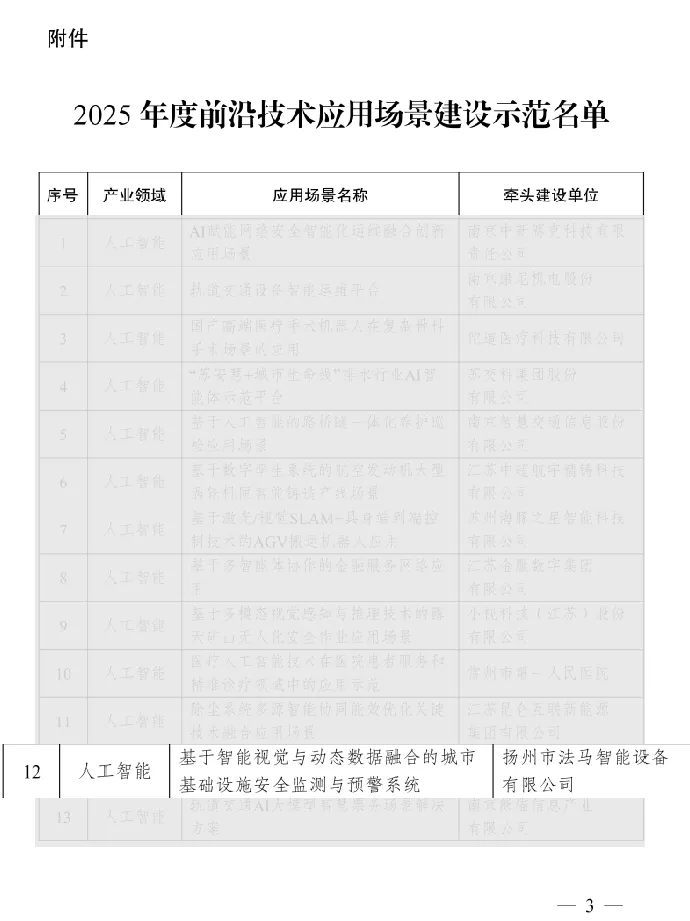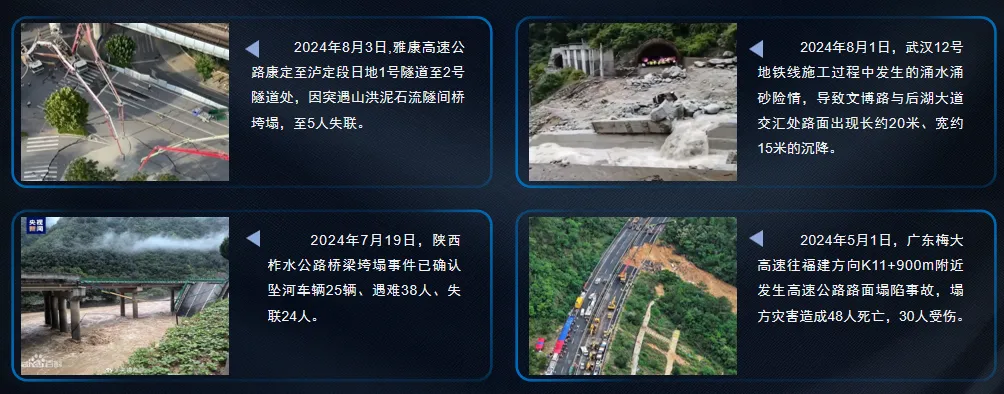Home > News > Company News > FAMA Was Selected into the 2025 Demonstration List for Frontier Technology Application Scenario Construction
FAMA Was Selected into the 2025 Demonstration List for Frontier Technology Application Scenario Construction
The Jiangsu Provincial Department of Science and Technology and the Provincial Development and Reform Commission recently announced the 2025 list of cutting-edge technology application scenario demonstration projects.
Yangzhou FAMA Intelligent Equipment Co.,Ltd. , Nanjing University of Information Science and Technology, and Shanghai Institute of Electric Power, combining their respective technological and engineering strengths, jointly developed the "Urban Infrastructure Security Monitoring and Early Warning System Based on Intelligent Vision and Dynamic Data Fusion" (referred to as "Xiong'an Star"). This solution was successfully selected for the 2025 list of cutting-edge technology application scenario demonstration projects, becoming a significant innovation in the field of smart city security monitoring.

Background: Urban Safety: An Urgent Need
In recent years, frequent extreme weather events and aging infrastructure have posed new challenges to urban safety management. Bridge collapses, road subsidence, landslides, and geological disasters—these emergencies not only threaten lives but also cause enormous economic losses.
The CPC Central Committee and the State Council have repeatedly emphasized the need to strengthen urban operations management and enhance safety risk prevention and control. In early 2024, the Ministry of Natural Resources and four other ministries jointly issued the "Notice on Strengthening Urban Geological Safety Risk Prevention and Control," which explicitly proposed the establishment of a "multi-source data monitoring and early warning platform" to achieve real-time perception and dynamic early warning of urban infrastructure. In May of the same year, the Ministry of Finance and the Ministry of Transport further emphasized the need to promote the digital upgrade of transportation infrastructure and improve efficiency in safety monitoring and emergency response by over 30%.

Driven by both policy initiatives and urban needs, "Xiong'an Star"—an urban infrastructure safety monitoring and early warning system based on the fusion of intelligent vision and dynamic data—came into being.
Proven in Practice: Successful Cases Nationwide
This system has been applied in several major projects, accumulating extensive practical experience:
Nanjing Lishui Landslide Geological Hazard Deformation Monitoring Project: Provides round-the-clock monitoring of landslides to ensure the safety of surrounding residents.
Beijing Landslide Geological Hazard Microwave Sound and Light Alarm Station Construction Project: Establishes a rapid response mechanism to effectively prevent disasters.
Tibet Yarlung Zangbo River Geological Hazard Monitoring Project: Provides stable monitoring in harsh natural environments to protect critical infrastructure.
Ordos Open-Pit Mine Automated Monitoring Project: Real-time monitoring of mining area deformation to ensure production safety.
Wuxi Ergan Bridge Vehicle-Axle Interconnected Monitoring Project: Through intelligent analysis, coordinated management of bridge safety and traffic flow is achieved.
The Nanjing Sudden Geological Hazard Monitoring and Early Warning Platform has received high praise from the Jiangsu Provincial Committee of the Communist Party of China and the Provincial People's Government.
System Solution: From "Visible" to "Knowing in Advance"
The system consists of Beidou monitoring equipment, intelligent sensors, an edge computing host, a radar-based integrated device, and a multi-source data fusion platform. It is deeply integrated with FAMA's core technologies for smart traffic control, smart traffic safety, and smart light poles to form a complete monitoring and early warning system, enabling all-weather, all-scenario, and real-time monitoring and early warning of urban infrastructure.
When sensors detect landslides or abnormal bridge deformation, they issue an abnormal deformation warning and push the data to nearby traffic lights. Upon receiving this information, the FAMA traffic light control system promptly activates a solid red light to prevent vehicles from entering dangerous sections of the road. Simultaneously, warnings are synchronized via the FAMA traffic safety information screen and the smart light pole system, providing multi-point visual alerts.
1. Millimeter-Level Precision Monitoring:
High-precision sensors deployed on bridges and slopes are integrated into the FAMA Smart Light Pole Gateway to monitor minute infrastructure deformations in real time.
2. Intelligent Warning Alerts:
The system integrates with the FAMA signal control system, traffic safety information screens, and smart light poles to issue immediate visual and information-based warnings, alerting vehicles and pedestrians to avoid danger.
3. Strong Adaptability to Extreme Weather:
It maintains stable operation in harsh conditions such as heavy rain and snowstorms, enabling all-weather monitoring and coordinated intersection control.
4. Decision Support:
Multi-source monitoring data collected by the system is synchronized and visualized on the platform in real time, providing scientific decision-making and emergency response support for government, transportation, and operation and maintenance departments.
Key Technologies: Empowering Safety with Technology
City-Level Intelligent Monitoring Cloud Platform
Combining AI and edge computing, the system can rapidly analyze data and automatically identify risks on-site, significantly reducing the burden of manual inspections and making monitoring more efficient and cost-effective.
Beidou + InSAR High-Precision Deformation Monitoring
By integrating satellite positioning and radar interferometry, it can monitor surface deformation at the millimeter level, providing early warning signals for disasters such as landslides and collapses.
AI Visual Subsidence Monitoring
Using cameras to intelligently identify subtle changes in bridges and roads, it can accurately determine structural abnormalities, similar to a doctor's auscultation, enabling low-cost, high-precision visual monitoring.
Multi-Source Data Fusion and Risk Analysis
The system integrates and cleans data from various sources, including sensors, Beidou, and remote sensing. Using models, it calculates the structural safety status, ensuring more accurate monitoring results and more reliable early warnings.
Intelligent Traffic Situation Prediction
Integrating traffic sensing devices with AI algorithms, the system can simulate various traffic flow scenarios, predict congestion and accident risks in advance, and provide cities with intelligent signal dispatching solutions, achieving "proactive traffic release, safety, and efficiency."
The selected innovative solutions combine the strengths of industry, academia, and research: Yangzhou FAMA Intelligent Equipment Co.,Ltd. , leveraging its large-scale hardware development and production capabilities, provides advanced monitoring equipment; Nanjing University of Information Science and Technology, leveraging its research strength in key meteorological models and artificial intelligence algorithms, is responsible for core technology innovation; and Shanghai University of Dianji provides technical support in intelligent visual analysis.
Through the development of this system, FAMA's products have significantly enhanced their intelligent perception and linkage capabilities. From intersection signal control and traffic safety warnings to bridge monitoring and road slope warnings, FAMA's products are being empowered with more urban perception and safety protection functions.
Going forward, FAMA will continue to deepen its intelligent vision and dynamic data fusion technology, enabling more transportation facilities to possess "perception and judgment capabilities," thereby continuously expanding the application boundaries of smart transportation and urban safety.
